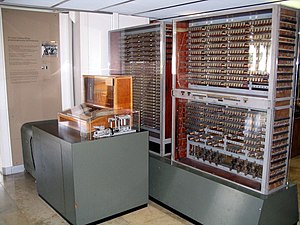Z3 (computer)
Zuse Z3 replica on display at Deutsches Museum in Munich
The Z3 was an electromechanical computer designed by Konrad Zuse. It was the world’s first working programmable, fully automatic digital computer.[1] The Z3 was built with 2,000 relays, implementing a 22-bit word length that operated at a clock frequency of about 5–10 Hz.[2]Program code[3] and constant data were stored on punched film.
The Z3 was completed in Berlin in 1941. The German Aircraft Research Institute used it to perform statistical analyses of wing flutter.[4]Zuse asked the German government for funding to replace the relays with fully electronic switches, but funding was denied during World War II since such development was deemed “not war-important”.[5]:148 The original Z3 was destroyed in 1943 during an Allied bombardment of Berlin. The Z3 was originally called V3 (Versuchsmodell 3 or Experimental Model 3) but was renamed to not be confused with Germany’s V-weapons.[6] A fully functioning replica was built in the 1960s by Zuse’s company, Zuse KG, and is on permanent display at Deutsches Museum in Munich. The Z3 was demonstrated in 1998 to be, in principle, Turing-complete.[7][8] However, because it lacked conditional branching, the Z3 only meets this definition by speculatively computing all possible outcomes of a calculation.
Thanks to this machine and its predecessors, Konrad Zuse is often regarded as the inventor of the computer.
